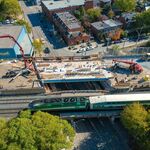kamira51
Active Member
The funny thing about all this, building a highway is 100x easier to build than it is a new railway corridor, and any other form of transit, what a joke.I guess this explains your obsession with highways...
The funny thing about all this, building a highway is 100x easier to build than it is a new railway corridor, and any other form of transit, what a joke.I guess this explains your obsession with highways...
My obsession is with free & unrestricted movement, convenience, and getting places quickly.I guess this explains your obsession with highways...
Or, with my own knowledge of my community, I could tell you the popularity was because of the convenience of the highway.Evidence, as in academic studies, generally show a price discount of ~ 4% for homes near higher traffic highways vs what they would otherwise be. Most clearly measured in a study on the construction of a new highway in the Orlando, Fl area.
There were exceptions, based on quality noise barriers and/or proximity of on/off ramps.
But beyond that, you'll find, highways rarely go through the most affluent communities and rarely do those form along a highway route.
In Toronto, property values are among the most depressed in the 401 corridor, with the exception of Avenue to Bayview.
But its notable that on the south side of that highway (in that stretch), you have some incredibly expensive homes that are, to a great degree shielded from the highway by natural valley features. (The highway noise passes over them; while the visual is largely hidden).
****
You, of course, may have a different preference.
Citation: https://www.jstor.org/stable/24860906
My obsession is with free & unrestricted movement, convenience, and getting places quickly.
My obsession is with free & unrestricted movement, convenience, and getting places quickly.
Subsidy is a dicey argument.
As a matter of policy, I would favor tolling the central areas of big cities, similar to London UK.
Is it? When the pitch for the 413 is the it's going to facilitate a bunch of low density single family detached subdivisions, it's pretty clear this is about perpetuating the growth ponzi scheme:
We had a Liberal government that was unwilling to even put a $2 toll on the Gardiner to pay for its rehabilitation. What makes you think a congestion charge will be even close to politically tenable in our lifetimes?
So, in our reality of cowardly politicians who won't expend any political capital to reduce car dependency, the only alternative to maintain a strict line against sprawl. And to hold a strict line on cost recovery where allowed.
Toronto can only do what it is specifically empowered to do by the province, I don't think it has the power to implement a congestion charge. They were given the power to collect tolls on highways, but the LPO chickened out when the city actually tried to use that power.Btw, an area entry charge will be less dependent on the provincial concent. Technically the situation is the same, Gardiner / DVP are owned by the city and the ordinary streets are owned by the city. But the optics is different; the province feels it can interfere in the decision affecting the highways, but it would be hard for the province to deny the city the righ to manage its regular streets.
Indeed, I am not in favor of the 413 as proposed. The route runs too close to the GTA centre, will act as a sprawl magnet, and might increase the congestion on the 400 and 410 during the weekday rush.
I would have no objections to a new 4xx highway bypassing the GTA entirely, connecting Cambridge to Barrie via Orangeville and letting the goods flow between the Golden Horseshoe and the North to bypass the busiest highways. Not sure if the numbers are there now though.
Hmm, I feel like proposals for a rural ring road that go like this don't have a huge business case. Even the case for the 413 itself is stronger, as it would serve York Region - Peel/Etobicoke/points further west destinations. I assume there is at least some demand for that. But most truck traffic is going into the GTHA, and I think it would be too large of a detour for them to use it. So unfortunately, the case for a rural road like that, as I see it, is non-existent.I called a road builders fever dream but I had suggested a new 4xx series highway running from roughly the 400/11 split North of Barrie and travelling roughly South-West towards the North end of Kitchener. There would also be the opportunity to connect this highway to the proposed Mid Penn highway. In effect this would allow commercial traffic from/to Northern Ontario to reach the US border all while completely bypassing the GTA.
But ahh, I admit that is a fantastical proposal and I don't know how much traffic it would be projected to see.
Hmm, I feel like proposals for a rural ring road that go like this don't have a huge business case. Even the case for the 413 itself is stronger, as it would serve York Region - Peel/Etobicoke/points further west destinations. I assume there is at least some demand for that. But most truck traffic is going into the GTHA, and I think it would be too large of a detour for them to use it. So unfortunately, the case for a rural road like that, as I see it, is non-existent.




